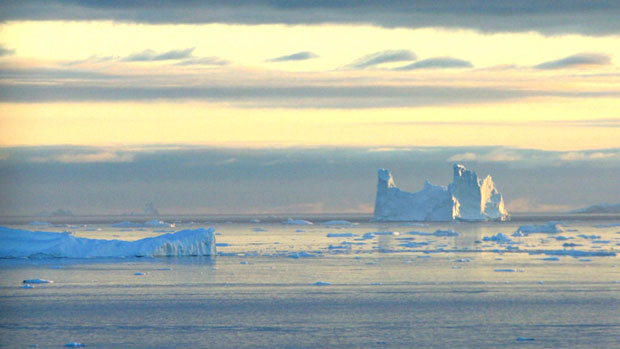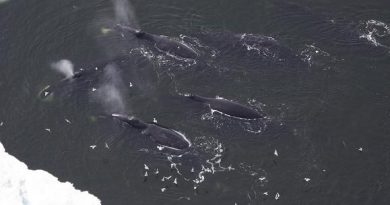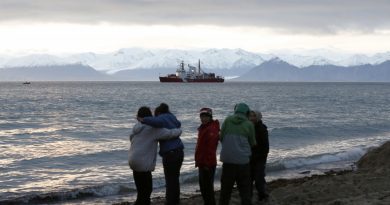Global cooling? London newspapers ignite controversy over Arctic climate change

The kerfuffle over climate change is heating up anew thanks to relatively cooler temperatures atop the globe that have resulted in a lot more sea ice this summer than last.
Warming skeptics are ballyhooing the turnaround, with the tabloid conservative newspaper The Daily Mail on Sunday screaming, “And now it’s global COOLING!” and U.K.’s right-wing Telegraph publishing a similar article.
The pieces rocketed across the Internet, but many say the change is a one-year reversal in line with long-term warming trends. While the Arctic sea ice in August stretched farther than it did 12 months ago, it remained hundreds of thousands of square miles below the long-term average, according to the National Snow and Ice Data Center (NSIDC).
‘Irresponsible reporting’?
On Monday, the lead scientist at the NSIDC, based at the University of Colorado in Boulder, blasted the articles on Monday for “playing games” with world opinion.
“It was very irresponsible reporting on their part,” said Ted Scambos, a glaciologist with the ice center. “They know what they’re saying and how they are saying it, and to say what they said they had to cherry pick facts.”
Scambos said the Arctic this summer was 2 to 3 degrees cooler than average, and the extent of sea ice in August was a “big increase” for a year-to-year jump. The sea ice was about the size of four Alaskas, at 2.35 million square miles, a 45 percent increase from the same time last year.
But that’s about the same size of sea-ice coverage in August 2009, which turned out to be one of the lowest years on record, Scambos said.
It was nothing close to the years before 2002. In fact, the sea-ice extent in August remained nearly 400,000 square miles less than the average between 1981 and 2010, with an amount of ice the size of Columbia in South America missing.
After record low years, some scientists expected an improvement this year, Scambos said.
The newspapers engaged in a very “poor level of communication” about what’s happening, Scambos said. “You’d have to have a very unusual perspective to describe things the way they did and it’s clear they do have that different perspective,” Scambos said.
Moreover, the Mail miscalculated the numbers, saying sea ice had grown by 60 percent year to year, Scambos said. In fact, it’s been a 45 percent increase since 2012 — still significant but quite different than what was reported, Scambos said.
Cherry picking?
The Guardian, a more left-leaning newspaper, blasted the Mail and the Telegraph, saying they can typically be relied on “to get the science wrong.” The Guardian noted that summer sea ice volume has diminished 75 percent over the last three decades.
“In short, this year’s higher sea ice extent is merely due to the fact that last year’s minimum extent was record-shattering, and the weather was not as optimal for sea ice loss this summer. However, the long-term trend is one of rapid Arctic sea ice decline, and research has shown this is mostly due to human-caused global warming,” said the Guardian.
The conservative Mail also mocked a prediction made six years ago by scientist Wieslaw Maslowski, a researcher at the U. S. Naval Postgraduate School in Monterey, Calif., who forecast ice-free Arctic seas as early as this year.
That’s more cherry-picking, said Scambos.
That was a single prediction by one scientist and “it got amplified out of proportion to what the majority of scientists were saying,” Scambos said. “Some skeptics would have all of us live with this prediction, but in fact very few people stepped up to back that prediction when it was made.”
It will be decades before the Arctic is free of every speck of ice in the late summer, Scambos said. More important is when summer sea ice shrinks to about 400,000 square miles (think Colombia again). At that point the Arctic Ocean reaches a tipping point with such factors as darker and warmer waters ensuring that the North Pole is largely free of ice in August and September.
Notably, the August sea ice is thinner and patchier than it once was because the sea ice that survives summer to grow in thickness has shrunk dramatically.
Zero sea ice
“In this so-called recovery, sea ice remains very thin and there are persistent holes and patches appearing within the ice cap” during September, when the ice shrinks to its minimum size each year.
This year’s sea ice is still shrinking, but the heated exchanges could rage on for years, said Scambos.
“If we stick to this thing about zero sea ice, people will continue to fly all over the Arctic saying, ‘Wait, I found a piece of ice, you’re wrong.’ ”
The increase looks extreme compared to such lows, he said.
Contact Alex DeMarban at alex(at)alaskadispatch.com



